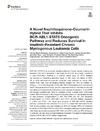Please use this identifier to cite or link to this item:
https://accedacris.ulpgc.es/handle/10553/69815
| Title: | A novel naphthoquinone-coumarin hybrid that inhibits BCR-ABL1-STAT5 oncogenic pathway and reduces survival in imatinib-resistant chronic myelogenous leukemia cells | Authors: | Martín-Rodríguez, Patricia Guerra, Borja Hueso-Falcón, Idaira Aranda Tavío, Haidee Magdalena Díaz-Chico, Juan Quintana Aguiar, José Martín Estévez, Francisco Díaz-Chico, Bonifacio Amesty, Angel Estévez-Braun, Ana Fernández-Pérez, Leandro |
UNESCO Clasification: | 320101 Oncología 3209 Farmacología |
Keywords: | Bcr-Abl1 Coumarin Drug Resistance Imatinib Leukemia, et al |
Issue Date: | 2019 | Project: | Desarrollo Preclínico de Nuevas Estructuras Bioactivas Moduladoras de Las Actividades Oncogénicas de Stat3/5 O de Los Receptores de Estrógenos Desarrollo Preclínico de Nuevas Estructuras Bioactivas Moduladoras de Las Actividades Oncogénicas de Stat3/5 O de Los Receptores de Estrógenos |
Journal: | Frontiers in Pharmacology | Abstract: | This is an open-access article distributed under the terms of the Creative Commons Attribution License (CC BY). BCR-ABL1-STAT5 is an oncogenic signaling pathway in human chronic myelogenous leukemia (CML) and it represents a valid target for anti-CML drug design. Resistance to direct BCR-ABL1 inhibitors is a common clinical issue, so STAT5 inhibition has become an interesting alternative target. In this study, the effects of NPQ-C6, a novel naphtoquinone-coumarin conjugate, were evaluated on human CML-derived K562 cells. Live-Cell Imaging analysis revealed that NPQ-C6 inhibited 2D (IC50AUC = 1.4 ± 0.6 μM) growth of CML cells. NPQ-C6 increased sub-G1 and reduced G0/G1 cell cycle phases in a dose- and time-dependent manner. This effect on cell cycle was related to increased levels of apoptotic nuclei, cleavage of caspase-3, -9, and PARP and annexin V-positive cells. NPQ-C6 increased γH2AX, a double-strand DNA break marker. NPQ-C6 showed a wide range of modulatory effects on cell signaling through an early increased phosphorylation of JNK, P38-MAPK and AKT, and decreased phosphorylation of ERK1/2, BCR-ABL1, and STAT5. NPQ-C6 inhibited expression of c-MYC and PYM-1, two target gene products of BCR-ABL1/STAT5 signaling pathway. Cytokine-induced activation of STAT5/STAT3-dependent transcriptional and DNA binding activities were also inhibited by NPQ-C6. Notably, NPQ-C6 maintained its activity on BCR-ABL1/STAT5/c-MYC/PIM-1 oncogenic pathway in imatinib-resistant cells. Molecular modeling suggested BCR-ABL1 and JAK2 proteins as NPQ-C6 targets. In summary, our data show a novel multikinase modulator that might be therapeutically effective in BCR-ABL1-STAT5-related malignancies. | URI: | https://accedacris.ulpgc.es/handle/10553/69815 | ISSN: | 1663-9812 | DOI: | 10.3389/fphar.2018.01546 | Source: | Frontiers In Pharmacology [ISSN 1663-9812], v. 9, (Enero 2019) |
| Appears in Collections: | Artículos |
SCOPUSTM
Citations
10
checked on Jun 8, 2025
WEB OF SCIENCETM
Citations
10
checked on Jun 8, 2025
Page view(s)
252
checked on May 17, 2025
Download(s)
162
checked on May 17, 2025
Google ScholarTM
Check
Altmetric
Share
Export metadata
Items in accedaCRIS are protected by copyright, with all rights reserved, unless otherwise indicated.
